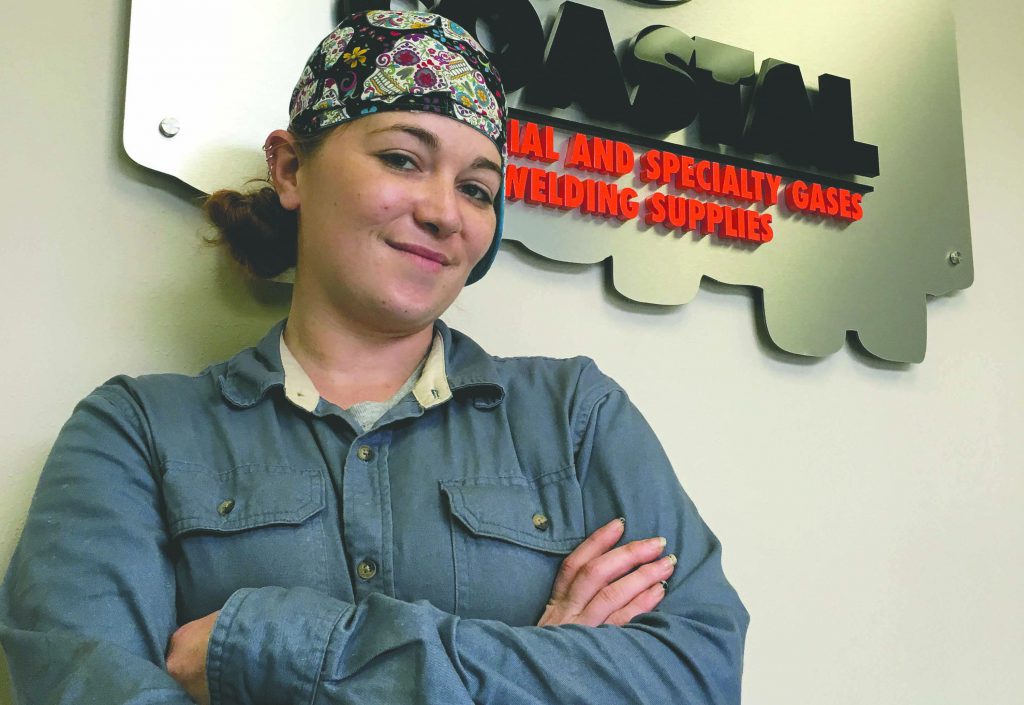A young hairdresser from southern New Jersey leaves her family and home to follow her welder boyfriend to a job in Southeast Texas. The relationship doesn’t work out. Now alone, far from her Yankee upbringing, she realizes that a welder’s salary trumps her cosmetology degree. So what does she do? She trades in her scissors for a torch and enrolls in a welding program.

Sound like a pitch for a network sitcom? It could be a first-season hit, but this is real life for Michelle Dillon, a 31-year-old welding student at Lamar Institute of Technology.
“There was a huge pay difference in salon work here, compared to up north,” said Dillon. “I was fascinated with what I knew about welding and started looking and investigating trade and welding schools in the area.”
Dillon said she did her research, and LIT seemed the perfect fit.
“I applied for student aid, enrolled and later received scholarship support from Coastal Welding Supply,” said Dillon, now a resident of Port Arthur.
That was two years ago. She will most likely graduate in December or January. When she receives her certification, Dillon will join a much-needed workforce.
The American Welding Society (AWS) predicts a 290,000-welder deficit by 2020. This shortage of workers is primarily due to the large number of welders hitting retirement age. And, nowhere in the U.S. is the demand higher for welders than the Gulf Coast region. In fact, in 2014, Peter Huntsman, chief executive officer of chemical maker Huntsman Corp. told Bloomberg the shortage of welders was so high that “you can take every citizen in the region of Lake Charles between the ages of 5 and 85 and teach them all how to weld, and you’re not going to have enough welders.”
“I’m amazed at the potential for job opportunities, here, compared to up north,” Dillon said. “The projects that are currently in progress and the recently announced expansions like Exxon and other 2017 industrial start ups are exciting. The graduates I know from LIT’s welding program have started out in their first jobs at $27 an hour. With experience, many are earning $32 to $42 an hour!”
When asked if her career choice was based solely on salary, she laughed and said, “I actually grew up with welders. My grandfather was a welder and he built the sets for the movie ‘Terminator 2’ in California. That’s where he met my grandmother, who worked in the HR Department. She later started welding too!”
But as a granddaughter with two brothers, Michelle said she was “shielded “from any of her grandfather’s welding talents but truly appreciates his skills now.
“When something is welded, it lasts a lifetime,” she said. “I have a barbecue grill in the back yard of my home that was welded by my grandfather years ago, and it looks like it was made yesterday. People don’t realize the things that they see every day involve welding. That’s why I want to weld … to be a part of and make something that lasts a lifetime.”
So what is it like to be a female in a male dominated industry? “This semester I am one of only three women in my class of 15. Last semester, there was only one other than me, so women are starting to see this is a great career,” she said. “I have a 41-year-old female classmate who wanted to go back to school to share with her son that you’re never too old to try something new.”
When asked if she has encountered any problems being a female welding student in an male environment, she said, “To be honest, when I first started at LIT, it was a language thing. I had my Jersey accent and my class was speaking Southeast Texas. That took some getting used to. I also found that women have to adjust to height and arm length restrictions.” She shared that, because of her small, 5-foot-2 frame, she did not have the arm length needed for traditional weld positions.
“What I have learned as a female welder is that you adapt,” Dillon said. “I can find ways to get into a weld and be as good as the guys. You just have to be creative in the way you are welding. “Plus, there is always a need for small welders in confined welding space jobs,” she added with a smile.
Written by: Cindy Yohe Lindsay, Coastal Welding Supply










